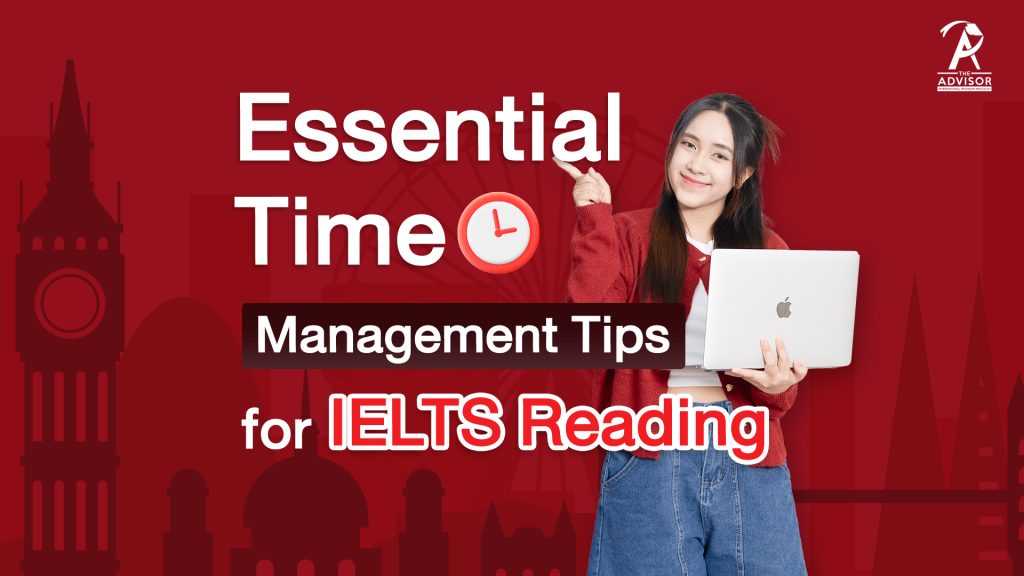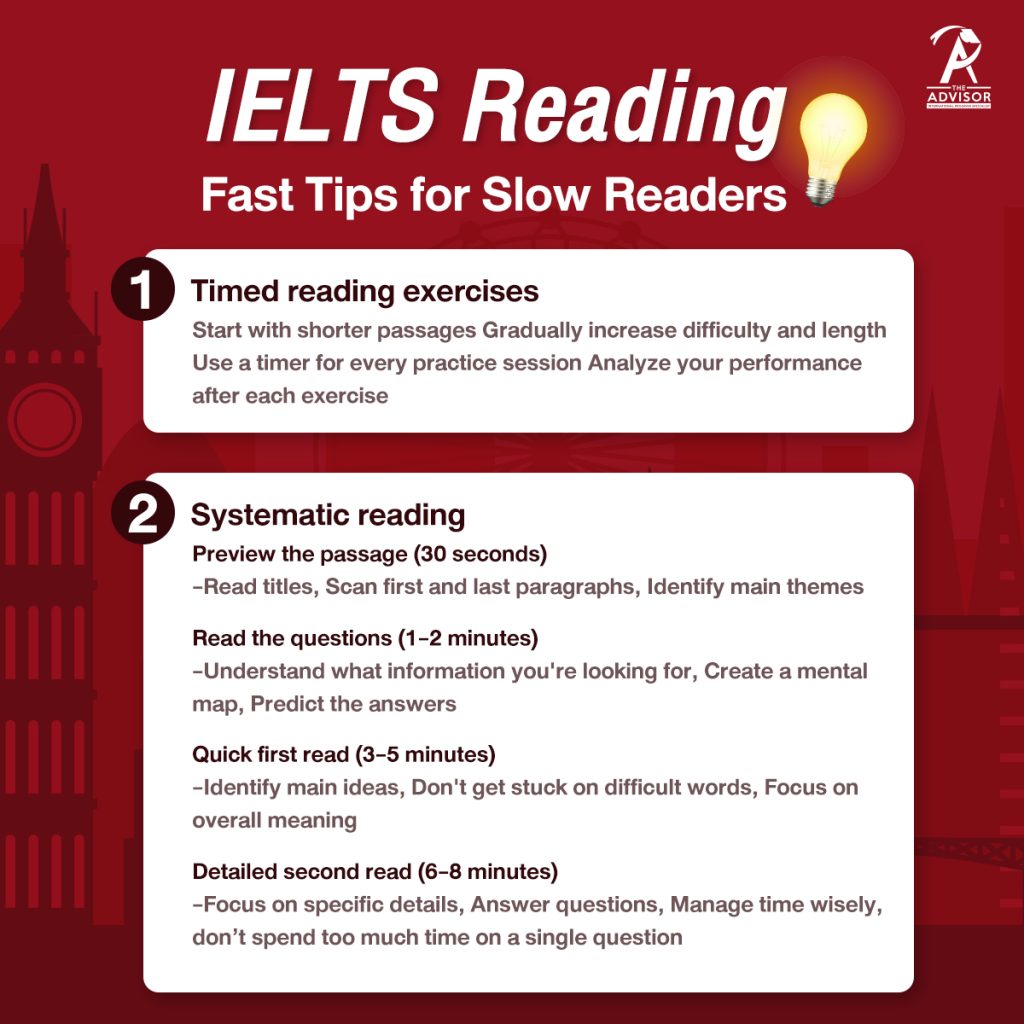Essential Time Management Tips for IELTS Reading

With 40 questions to answer within just one hour, the IELTS reading test can feel like a high-stakes race against time for many students, especially those who take the test for the first time or are slow readers. If you want to finish the IELTS reading test on time, here is a comprehensive guide to provide you with essential strategies to manage your time effectively and maximize your performance.
Time Allocation for IELTS Reading Sections
Effective time management begins with a strategic approach to the exam’s structure. You have 60 minutes to complete 40 questions across three passages. You should spend approximately 16-18 minutes on each passage. Next, set aside an extra 5 minutes for reviewing your answers. Here’s a breakdown of a time allocation:
- Passage 1 (16-18 minutes)
- Passage 2 (16-18 minutes)
- Passage 3 (16-18 minutes)
- Extra 5 minutes for review
Tips to Complete IELTS Reading Faster
Speed is crucial in the IELTS reading test, but it is not all about fast reading; rather, strategic reading plays a much bigger role in your IELTS success. Follow these tips to complete IELTS reading faster:
- Skimming and scanning
Skimming and scanning are essential skills that can remarkably improve your reading speed. Skimming involves quickly gliding over the text to understand the main idea, and scanning helps you locate specific information rapidly.
When skimming, focus on:
- Topic sentences
- First and last paragraphs
- Headings and subheadings
- First sentences of each paragraph
When scanning, focus on:
- Specific keywords
- Numerical data
- Uncommon names or specific terms
- Prioritize easier questions
Not all questions are created equal. Some are easier and more straightforward than others. Start with questions you find easiest and don’t waste time on a single challenging question. Instead, move on to finish the rest and return to the unanswered question later, if time permits.
By tackling easier questions first, you:
- Build confidence
- Secure quick points
- Save time for more complex questions
- Reduce exam stress
- Practice active reading
Active reading is a focused and engaged approach to reading where the reader interacts with the text to enhance understanding and retention. It involves the following strategies:
- Mentally highlight key information as you progress through the passage
- Ask yourself questions about the text
- Predict potential answers
- Connect ideas across paragraphs
- Stay fully focused and engaged to the text
- Use a finger or a pointer to guide your reading
This tip sounds so simple—almost too simple, but it works. Using a finger or a pointer to guide your eyes across the text can help maintain concentration and increase reading speed. It also reduces eye strain, prevents losing your place in the text, and creates physical rhythm for reading.
Here’s how it works:
- Use your finger or a pen to track text
- Move slightly faster than your natural reading pace
- Practice this technique during mock tests
- Adjust speed based on text complexity
Avoid Running Out of Time in IELTS Reading
Unfortunately, many test-takers unknowingly sabotage their performance through poor time management. They run out of time to complete all questions, and those missing answers cost valuable points. Here are some common mistakes to avoid:
- Spending too much time on one passage
The mistake:
A lot of test-takers become overly invested in a single challenging passage and lose sight of the overall exam strategy. This narrow focus can significantly diminish your chances of successfully completing all sections. Remember, the IELTS reading test has three passages. Avoid losing focus while working on one passage.
How to avoid it:
- Allocate a strict time limit for each passage (approximately 15-20 minutes)
- Practice the 80/20 rule—if a question is taking too long, move on
- Remember that all questions carry equal weight
Tip: During practice tests, time yourself strictly. If you spend more than 25 minutes on a single passage, you’re putting your entire exam at risk.
- Getting stuck on difficult questions
The mistake
You should not spend several minutes trying to solve a single question that may not significantly impact your overall score. In the IELTS reading test, all questions are worth the same number of points, regardless of their difficulty level. An easy question and a difficult question both contribute equally to your total score.
How to avoid it:
- Don’t spend more than 2-3 minutes on any single question
- Prioritize answering questions you can confidently solve
Strategy:
- Easy questions: Answer immediately
- Moderate questions: Come back if time permits
- Difficult questions: Skip and return only if you have extra time
- Not spending enough time reading the instructions carefully
The mistake
While it is true that every second counts during the test, you should be generous with the few minutes spent carefully reviewing the instructions. This can prevent you from wasting several more minutes due to misunderstanding what is expected from your answers, which could potentially result in significant score reductions.
How to avoid it:
- Read the instructions for each section carefully
- Pay attention to word limits in short answer questions
- Understand specific requirements for each question type (whether to answer with words that are written exactly as in the text)
- Getting trapped by paraphrasing and synonyms
Paraphrased language and synonyms are keys to the IELTS True, False, Not Given section. Test-takers often make the mistake of looking for exact word matches, which can lead to incorrect answers. For example, if the passage says “young individuals” and the statement mentions “teenagers,” these could be referring to the same group. You need to understand the underlying meaning, not just look for identical words.
IELTS Reading Fast Tips for Slow Readers
Being a slow reader doesn’t mean you can’t excel in the IELTS reading test. With targeted strategies and consistent practice, you can improve your reading speed and comprehension. Follow these tips to read faster:
- Timed reading exercises
Set a timer and challenge yourself to complete reading passages within strict time limits. Use a variety of texts—academic journals, newspaper articles, and scientific publications—to diversify your reading experience. Here’s a structured practice routine:
- Start with shorter passages
- Gradually increase difficulty and length
- Use a timer for every practice session
- Analyze your performance after each exercise
- Systematic reading
A systematic reading practice helps simulate the real exam conditions, identify areas for improvement, track your reading progress, and build confidence under time pressure. Here’s a recommended pattern for a single passage reading:
- Preview the passage (30 seconds)
- Read titles
- Scan first and last paragraphs
- Identify main themes
- Read the questions (1-2 minutes)
- Understand what information you’re looking for
- Create a mental map
- Predict the answers
- Quick first read (3-5 minutes)
- Identify main ideas
- Don’t get stuck on difficult words
- Focus on overall meaning
- Detailed second read (6-8 minutes)
- Focus on specific details
- Answer questions
- Manage time wisely, don’t spend too much time on a single question
must develop active reading skills to distinguish statements that are explicitly supported, contradicted, or neither confirmed nor refuted in the text. Remember: Precision, careful reading, and a strategic approach are your keys to success!

Conclusion
By following these time management tips for IELTS reading, you are most likely to finish the test on time without leaving any question blank. Remember: Your goal is not fast reading but strategic reading that gets you the highest score.